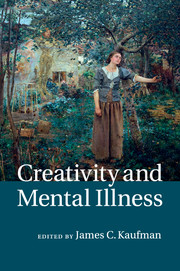Book contents
- Frontmatter
- Dedication
- Contents
- List of figures
- List of tables
- List of contributors
- Preface
- Acknowledgments
- Part I Creativity and mental illness: the state of the field
- Part II Cognitive and neuroscientific perspectives on creativity and mental illness
- Part III Creativity and the spectrum of mental illness
- Part IV Creativity and mental illness: possible commonalities
- Part V Creativity and mental health
- Part VI Creativity and mental illness: what now?
- 18 Ruminating about mental illness and creativity
- 19 Creativity and mental illness: reasons to care and beware
- Index
- References
18 - Ruminating about mental illness and creativity
from Part VI - Creativity and mental illness: what now?
Published online by Cambridge University Press: 05 August 2014
- Frontmatter
- Dedication
- Contents
- List of figures
- List of tables
- List of contributors
- Preface
- Acknowledgments
- Part I Creativity and mental illness: the state of the field
- Part II Cognitive and neuroscientific perspectives on creativity and mental illness
- Part III Creativity and the spectrum of mental illness
- Part IV Creativity and mental illness: possible commonalities
- Part V Creativity and mental health
- Part VI Creativity and mental illness: what now?
- 18 Ruminating about mental illness and creativity
- 19 Creativity and mental illness: reasons to care and beware
- Index
- References
Summary
Ruminating about mental illness and creativity
Although a popular one, the question of whether mental illness is good for creativity is not new. As Becker discusses in his chapter, the ancient Greeks were speculating about “madness” and how it relates to creative genius long before the Renaissance-era artists thought to paint portraits of Italian emperors as piles of twigs and gourds (see Giuseppe Arcimboldo, sixteenth century), or the Romanticists composed paintings of grown men eating babies (Francisco Goya – Saturn devouring his son, c.1819) and people biting one another to steal each other’s identities (William-Adolphe Bouguereau – Dante and Virgil in Hell, 1850). In fact, Socrates, Plato, and Aristotle carried on a philosophical tradition of questioning the “divine madness” of inspiration. It was thought in ancient Greece that the greatness of poets and prophets was a gift bestowed upon people in an altered state of awareness by the gods (or demons, depending on whom we’re asking). Periodically since then, artists, poets, and philosophers were thought to be able to create because of divine demonic intervention, “melancholia,” disease, drug use, or the like. And we, as researchers, are left to sift through the madness (or lack thereof) in search of evidence that this relationship actually exists (or doesn’t).
In this chapter, we offer some reflections – or ruminations, as befits the occasion – on creativity and mental illness. These ideas are abstracted from and inspired by this interesting batch of chapters. We’ll ponder a few topics: whether mental illness is specific to a few creative domains, why links exist when they are found, and what to take away from this large and sprawling literature.
- Type
- Chapter
- Information
- Creativity and Mental Illness , pp. 395 - 402Publisher: Cambridge University PressPrint publication year: 2014
References
- 1
- Cited by

